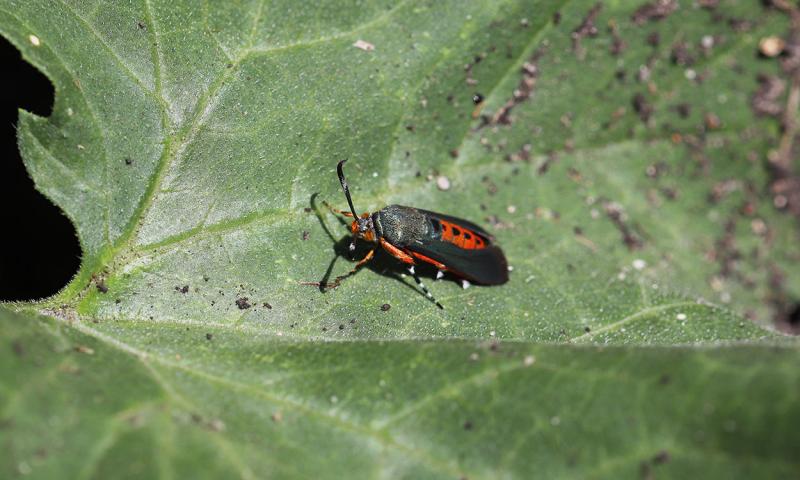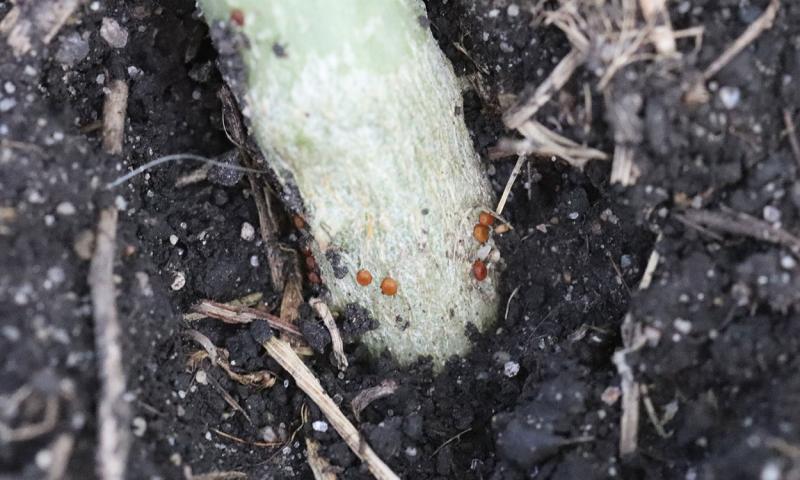
Originally submitted: June 16, 2021
While scouting my garden I spotted numerous squash vine borer moths (Figure 1). This seems to be right on track with the degree day estimates for squash vine borer activity throughout much of South Dakota this week. Now that we know squash vine borer moths are active, it is important to take steps to ensure that they don’t have a negative impact on our squash plants.
Identification
Squash vine borer adults belong to the clear-winged moth family (Sesiidae). These moths are often confused with wasps or bees due to their coloration and their clear wings. The squash vine borer moths are approximately ½ of an inch long. They have an orange abdomen with a black spot on the top of each abdominal segment. The front pair of wings (closer to the head) are metallic green, while the hind wings are clear. The antennae have a white band, and the legs have similar white banding (Figure 1).

The larvae of the squash vine borer are cream-colored with a dark-brown head and dark-brown pronotum (segment directly behind the head). The larvae will also have dark spots on each segment of their body (Figure 2). They are commonly found near the base of the plant inside the stems. Their feeding will result in a sawdust-like material being pushed out onto the stem, leaves or surrounding soil.
The female squash vine borer moths lay eggs on the stem of vine crops near the soil surface. The eggs are flattened and reddish-brown in color (Figure 3). Each egg is approximately 1/30 of an inch in diameter, which is very small, yet still visible upon close inspection (especially with magnification).
Lifecycle

Squash vine borer adult emergence typically occurs in late June through early July. However, the warm weather we have been experiencing has allowed them to emerge earlier than normal. They are good fliers, so they can travel long distances. Unlike most moths, squash vine borer adults are active during the day instead of at night. After emergence and mating, the female moth will lay eggs at the base of plants. The eggs soon hatch, and the larvae bore into the stems to feed. The larvae will feed within the stem, which blocks water and nutrient flow to the rest of the plant, resulting in wilting. The squash vine borer larvae will feed for four to six weeks before exiting the stems and pupating in the soil.
Management
Monitoring for adult squash vine borers may allow management before the plants become infested. The moths are similar to wasps and are noted for making a “buzzing” sound while flying. A homemade bait trap made from a yellow container filled with soapy water can be used to monitor and reduce adult populations. There are also commercial pheromone lures available, which can be an option for larger-scale operations or even home gardens.
Once adults are observed, scout the base of plants for eggs. Insecticides may be used when moths are active or when larvae begin to hatch. If using insecticides, make sure to read and follow the label directions and pay special attention to avoid treating the open flowers. It is also possible to remove the eggs and destroy them prior to hatch. Alternatively, an early and late-planting of squash can be used to ensure that some plants will not be affected by the squash vine borers.
If you observe an infested plant, remove it from your garden immediately and destroy it. Since cucurbits have multiple vines, you may be able to excise the damaged part of the plant and still retain fruit production. This will reduce the likelihood of the larvae successfully pupating and increasing the population for subsequent years. Spring and/or fall tillage of the garden will reduce the successful overwintering of the squash vine borer and may result in reduced populations during the following year.


